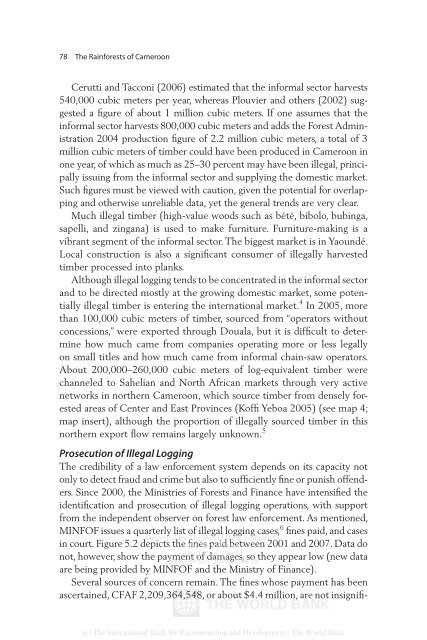The Rainforests of Cameroon - PROFOR
The Rainforests of Cameroon - PROFOR
The Rainforests of Cameroon - PROFOR
- No tags were found...
Create successful ePaper yourself
Turn your PDF publications into a flip-book with our unique Google optimized e-Paper software.
78 <strong>The</strong> <strong>Rainforests</strong> <strong>of</strong> <strong>Cameroon</strong>Cerutti and Tacconi (2006) estimated that the informal sector harvests540,000 cubic meters per year, whereas Plouvier and others (2002) suggesteda figure <strong>of</strong> about 1 million cubic meters. If one assumes that theinformal sector harvests 800,000 cubic meters and adds the Forest Administration2004 production figure <strong>of</strong> 2.2 million cubic meters, a total <strong>of</strong> 3million cubic meters <strong>of</strong> timber could have been produced in <strong>Cameroon</strong> inone year, <strong>of</strong> which as much as 25–30 percent may have been illegal, principallyissuing from the informal sector and supplying the domestic market.Such figures must be viewed with caution, given the potential for overlappingand otherwise unreliable data, yet the general trends are very clear.Much illegal timber (high-value woods such as bété, bibolo, bubinga,sapelli, and zingana) is used to make furniture. Furniture-making is avibrant segment <strong>of</strong> the informal sector. <strong>The</strong> biggest market is in Yaoundé.Local construction is also a significant consumer <strong>of</strong> illegally harvestedtimber processed into planks.Although illegal logging tends to be concentrated in the informal sectorand to be directed mostly at the growing domestic market, some potentiallyillegal timber is entering the international market. 4 In 2005, morethan 100,000 cubic meters <strong>of</strong> timber, sourced from “operators withoutconcessions,” were exported through Douala, but it is difficult to determinehow much came from companies operating more or less legallyon small titles and how much came from informal chain-saw operators.About 200,000–260,000 cubic meters <strong>of</strong> log-equivalent timber werechanneled to Sahelian and North African markets through very activenetworks in northern <strong>Cameroon</strong>, which source timber from densely forestedareas <strong>of</strong> Center and East Provinces (K<strong>of</strong>fi Yeboa 2005) (see map 4;map insert), although the proportion <strong>of</strong> illegally sourced timber in thisnorthern export flow remains largely unknown. 5Prosecution <strong>of</strong> Illegal Logging<strong>The</strong> credibility <strong>of</strong> a law enforcement system depends on its capacity notonly to detect fraud and crime but also to sufficiently fine or punish <strong>of</strong>fenders.Since 2000, the Ministries <strong>of</strong> Forests and Finance have intensified theidentification and prosecution <strong>of</strong> illegal logging operations, with supportfrom the independent observer on forest law enforcement. As mentioned,MINFOF issues a quarterly list <strong>of</strong> illegal logging cases, 6 fines paid, and casesDelivered by <strong>The</strong> World Bank e-library to:in court. Figure 5.2 depicts the <strong>The</strong> fines World paid Bank between 2001 and 2007. Data donot, however, show the payment IP : <strong>of</strong> 192.86.100.34 damages, so they appear low (new dataMon, 09 Nov 2009 17:06:18are being provided by MINFOF and the Ministry <strong>of</strong> Finance).Several sources <strong>of</strong> concern remain. <strong>The</strong> fines whose payment has beenascertained, CFAF 2,209,364,548, or about $4.4 million, are not insignifi-(c) <strong>The</strong> International Bank for Reconstruction and Development / <strong>The</strong> World Bank
















